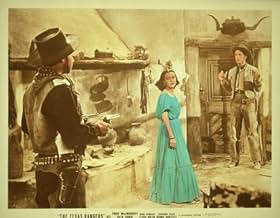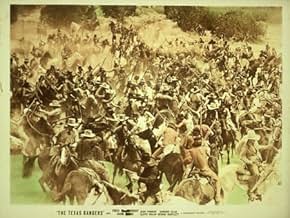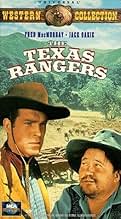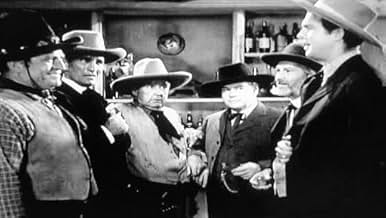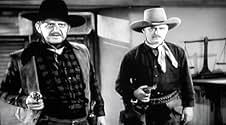Deux anciens hors-la-loi malchanceux se portent volontaires pour devenir des Texas Rangers et se retrouvent chargés d'arrêter un vieil ami, devenu un hors-la-loi notoire.Deux anciens hors-la-loi malchanceux se portent volontaires pour devenir des Texas Rangers et se retrouvent chargés d'arrêter un vieil ami, devenu un hors-la-loi notoire.Deux anciens hors-la-loi malchanceux se portent volontaires pour devenir des Texas Rangers et se retrouvent chargés d'arrêter un vieil ami, devenu un hors-la-loi notoire.
- Réalisation
- Scénario
- Casting principal
- Nommé pour 1 Oscar
- 1 nomination au total
Benny Bartlett
- David
- (as Bennie Bartlett)
Fred Kohler
- Jess Higgins
- (as Fred Kohler Sr.)
George 'Gabby' Hayes
- Judge Snow
- (as George Hayes)
Stanley Andrews
- First Higgins Henchman
- (non crédité)
Irving Bacon
- David's Father
- (non crédité)
Kathryn Bates
- School Teacher
- (non crédité)
John Beck
- Stage Passenger
- (non crédité)
Hank Bell
- Hank Wallace, Texas Ranger
- (non crédité)
Virginia Brissac
- David's Mother
- (non crédité)
Avis à la une
The copy I watched courtesy of YouTube was clean and crisp, and the film itself was good by the standards of the mid-1930s.
Unlike some other reviewers here on IMDb, I've always thought Fred MacMurray an acceptable Western actor, and I found Jack Okie irritating in the first part of the film - especially as he rode along with MacMurray anticipating a romantic encounter with a señorita. The back projection was reasonable enough, certainly compared with that in "The Plainsman", issued in the same year.
With much of the film being set before Texas became a state (which happened in 1845), there were lots of anachronisms - relating to the Rangers' kit and weapons for example. And the telegraph system was very much in its infancy - I wonder if it had reached Texas?
One might also mention the unrealistic death following the shot under the table.
On the plus side, the fight between the Rangers and the Indians was excellent and Lloyd Nolan in his early scenes radiated charisma - before reverting to the sort of nasty character he was to portray in later films.
Unlike some other reviewers here on IMDb, I've always thought Fred MacMurray an acceptable Western actor, and I found Jack Okie irritating in the first part of the film - especially as he rode along with MacMurray anticipating a romantic encounter with a señorita. The back projection was reasonable enough, certainly compared with that in "The Plainsman", issued in the same year.
With much of the film being set before Texas became a state (which happened in 1845), there were lots of anachronisms - relating to the Rangers' kit and weapons for example. And the telegraph system was very much in its infancy - I wonder if it had reached Texas?
One might also mention the unrealistic death following the shot under the table.
On the plus side, the fight between the Rangers and the Indians was excellent and Lloyd Nolan in his early scenes radiated charisma - before reverting to the sort of nasty character he was to portray in later films.
The Texas Rangers is directed by King Vidor who also co-writes with Elizabeth Hill, Louis Stevens and Walter Prescott Webb. It stars Fred MacMurray, Jack Oakie, Jean Parker and Lloyd Nolan. Music is by Gerard Carbonara and cinematography by Edward Cronjager. Plot has MacMurray and Oakie as two outlaws who decide to become Texas Rangers, something which invariably brings them into conflict with another outlaw pal.
It showcases the good and bad of 1930s Westerns. The action is strong and vibrant, the landscapes appealing and the story as a premise is always interesting. But those good points are countered with weak scripting, goofs, logic holes and a mixed bag of acting performances. But all told, Vidor's movie comes through its problems to stay firmly on the good side of good for the Western fan.
It's good guys versus bad guys on the home front, with the Indians lining up in numbers to be the common foe. It's here for the latter, where Vidor excels, constructing the action scenes with great skill as a ream of extras in Indian attire attack in their droves, arrows and bullets fly with murderous worth, bodies hurl and fall about, it's exciting stuff. The highlight coming as the Indians start flinging boulders off of a cliff face down onto the Rangers down below; the sound work here especially great, as is the stunt work in this whole segment of the film.
MacMurray and Oakie make a likable pair, but both seem a touch out of place in this portion of the Wild West. But Nolan cuts a nice snarly figure as chief villain Sam "Polka Dot" McGee, and he gets to deliver the film's best (nastiest) moment. Parker is pretty but pretty much a token, while secondary support slots are capably filled by the likes of Edward Ellis, Benny Bartlett and Frank Shannon. Cronjager's black and white photography is on the money, neatly utilising the New Mexico locations as wide open vistas that impose on the characters. While Carbonara scores it with standard Cowboys and Indian flavours for the attacks, and bombastic machismo for the Texas Rangers patrols.
Full of formula and mixed signals as to what it wants to be, The Texas Rangers is none the less an enjoyable picture and one of the better Oaters from the 30s. 7/10
Footnote: A sequel followed in 1940 called The Texas Rangers Ride Again. In 1949 The Texas Rangers was remade as Streets of Laredo, with William Holden starring.
It showcases the good and bad of 1930s Westerns. The action is strong and vibrant, the landscapes appealing and the story as a premise is always interesting. But those good points are countered with weak scripting, goofs, logic holes and a mixed bag of acting performances. But all told, Vidor's movie comes through its problems to stay firmly on the good side of good for the Western fan.
It's good guys versus bad guys on the home front, with the Indians lining up in numbers to be the common foe. It's here for the latter, where Vidor excels, constructing the action scenes with great skill as a ream of extras in Indian attire attack in their droves, arrows and bullets fly with murderous worth, bodies hurl and fall about, it's exciting stuff. The highlight coming as the Indians start flinging boulders off of a cliff face down onto the Rangers down below; the sound work here especially great, as is the stunt work in this whole segment of the film.
MacMurray and Oakie make a likable pair, but both seem a touch out of place in this portion of the Wild West. But Nolan cuts a nice snarly figure as chief villain Sam "Polka Dot" McGee, and he gets to deliver the film's best (nastiest) moment. Parker is pretty but pretty much a token, while secondary support slots are capably filled by the likes of Edward Ellis, Benny Bartlett and Frank Shannon. Cronjager's black and white photography is on the money, neatly utilising the New Mexico locations as wide open vistas that impose on the characters. While Carbonara scores it with standard Cowboys and Indian flavours for the attacks, and bombastic machismo for the Texas Rangers patrols.
Full of formula and mixed signals as to what it wants to be, The Texas Rangers is none the less an enjoyable picture and one of the better Oaters from the 30s. 7/10
Footnote: A sequel followed in 1940 called The Texas Rangers Ride Again. In 1949 The Texas Rangers was remade as Streets of Laredo, with William Holden starring.
The Texas Rangers (1936)
Routine. There are elements here of Westerns earlier (there were hundreds of obscure ones) and Westerns later (including some well known ones), with stagecoach holdups and cowboy and Indian battles (the Indians lose again) and with pioneer justice. All of the above, plus a man reluctant to see the love of a lonely and lovely woman out on the edge of nowhere.
In a sense, it isn't worth watching if you have other Westerns up your sleeve. But--there has to be a but--the plot is interesting because it turns upside down more times than a tumbleweed, the filming (with Cronjager behind the camera) is straight up and strong, and we get an early look at unlikely Wild West hero, Fred MacMurray. For those who like Westerns, this is a decent mid-30s example, before the explosion of greater examples in 1939.
The title is exactly what the movie is about on the surface--the ragtag but well supported Texas lawmen known as the Texas Rangers (legendary enough to not only have a more recent widely panned movie about them made starring Ashton Kushner but also a Baseball Team). It almost is a promo piece for the group, with a voice-over in the beginning like those FBI films of the 1950s. MacMurray is actually a bandit, teamed up with a kind of goofy second lead, Jack Oakey. In fact, it seems like a comedy at first, and the lightweight air never quite lets up.
It does get more serious, though, not only about love (briefly) but about the honor and ability of the Rangers to fight not only Indians but outlaws. MacMurray gets in the middle of a major mess because he plays both sides of the game, as outlaw and newbie Texas Ranger. Lloyd Nolan enters the plot after awhile and is a great outlaw of his own. It's hard to take MacMurray seriously in this rough rough world, but the music pumps it up and the scenery is dramatic and he holds his own well enough for a middling movie.
And it's a bit long. Even if the plot seems to demand two hours with more and more twists, it loses something of velocity as it goes. King Vidor directed a number of notable silents in the 20s, and a few great 30s films (including the black and white parts of the Wizard of Oz). This one shows the solidity of a great director, and the wobbly backbone of a so-so script.
Routine. There are elements here of Westerns earlier (there were hundreds of obscure ones) and Westerns later (including some well known ones), with stagecoach holdups and cowboy and Indian battles (the Indians lose again) and with pioneer justice. All of the above, plus a man reluctant to see the love of a lonely and lovely woman out on the edge of nowhere.
In a sense, it isn't worth watching if you have other Westerns up your sleeve. But--there has to be a but--the plot is interesting because it turns upside down more times than a tumbleweed, the filming (with Cronjager behind the camera) is straight up and strong, and we get an early look at unlikely Wild West hero, Fred MacMurray. For those who like Westerns, this is a decent mid-30s example, before the explosion of greater examples in 1939.
The title is exactly what the movie is about on the surface--the ragtag but well supported Texas lawmen known as the Texas Rangers (legendary enough to not only have a more recent widely panned movie about them made starring Ashton Kushner but also a Baseball Team). It almost is a promo piece for the group, with a voice-over in the beginning like those FBI films of the 1950s. MacMurray is actually a bandit, teamed up with a kind of goofy second lead, Jack Oakey. In fact, it seems like a comedy at first, and the lightweight air never quite lets up.
It does get more serious, though, not only about love (briefly) but about the honor and ability of the Rangers to fight not only Indians but outlaws. MacMurray gets in the middle of a major mess because he plays both sides of the game, as outlaw and newbie Texas Ranger. Lloyd Nolan enters the plot after awhile and is a great outlaw of his own. It's hard to take MacMurray seriously in this rough rough world, but the music pumps it up and the scenery is dramatic and he holds his own well enough for a middling movie.
And it's a bit long. Even if the plot seems to demand two hours with more and more twists, it loses something of velocity as it goes. King Vidor directed a number of notable silents in the 20s, and a few great 30s films (including the black and white parts of the Wizard of Oz). This one shows the solidity of a great director, and the wobbly backbone of a so-so script.
This to me is a magical western of the straightforward "goodies in white hats, baddies in black" genre. It has style, humour and excitement and should be compulsory viewing for every 12 year old and above.
I'm sure in casting The Texas Rangers Paramount had it in mind to broaden Fred MacMurray's appeal by putting him in a western. MacMurray had been a star at Paramount for two years and had appeared in mostly light comic parts as he did throughout his career. I mean Paramount could have cast Gary Cooper or Joel McCrea, both of whom were available at the studio. MacMurray did the film and gave a creditable performance, but as he remarked, "the horse and I were never as one." He never really did feel comfortable in westerns and ones he later appeared in were long after his Paramount studio days were over.
The Texas Rangers film is based on stories derived from Walter Presscott Webb's authoritative history of the legendary law enforcement outfit which was only published a few years back. Fred MacMurray, Jack Oakie and Lloyd Nolan play three outlaws who drift into Texas and become separated. MacMurray and Oakie join the Texas Rangers and Nolan continues his outlaw ways.
Lots of good action here folks. A really great Comanche Indian attack sequence is well staged by Director King Vidor. Lots of familiar western faces support the leads like Fred Kohler and Gabby Hayes. Edward Ellis as the commandant of the Texas Rangers comes off a lot like Lewis Stone and had MGM instead of Paramount had made this film, Lewis Stone definitely would have been cast in Ellis's role.
Despite MacMurray's misgivings about westerns, The Texas Rangers is a pretty good action western with great character development for the three leads.
The Texas Rangers film is based on stories derived from Walter Presscott Webb's authoritative history of the legendary law enforcement outfit which was only published a few years back. Fred MacMurray, Jack Oakie and Lloyd Nolan play three outlaws who drift into Texas and become separated. MacMurray and Oakie join the Texas Rangers and Nolan continues his outlaw ways.
Lots of good action here folks. A really great Comanche Indian attack sequence is well staged by Director King Vidor. Lots of familiar western faces support the leads like Fred Kohler and Gabby Hayes. Edward Ellis as the commandant of the Texas Rangers comes off a lot like Lewis Stone and had MGM instead of Paramount had made this film, Lewis Stone definitely would have been cast in Ellis's role.
Despite MacMurray's misgivings about westerns, The Texas Rangers is a pretty good action western with great character development for the three leads.
Le saviez-vous
- AnecdotesKing Vidor made this movie to honor the celebrations of the centennial of the state of Texas.
- GaffesHawkins and the other Rangers are surrounded by Indians. He kills the 2 Indians rolling rocks, throwing his empty pistol at one. As he descends the other side, he mounts a bareback horse, riding off shooting a pistol that shouldn't be there as he rides away.
- Citations
Wahoo Jones: How do you expect to find Sam down in this country? Texas! Phooey! No towns, no ranch houses, no gals, no nuthin'. Hah! We can't see a jack rabbit in two days. Boy, you can't tell me we're still in the United States!
- ConnexionsEdited into Le Retour des Texas Rangers (1940)
Meilleurs choix
Connectez-vous pour évaluer et suivre la liste de favoris afin de recevoir des recommandations personnalisées
Détails
- Durée1 heure 38 minutes
- Couleur
- Rapport de forme
- 1.37 : 1
Contribuer à cette page
Suggérer une modification ou ajouter du contenu manquant

Lacune principale
By what name was La légion des damnés (1936) officially released in India in English?
Répondre
